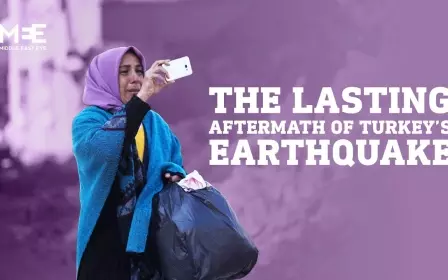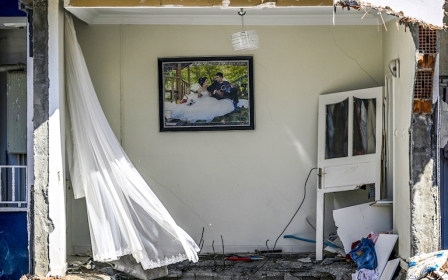Turkey earthquake: The media did not hold the government to account

It was early in the morning of Monday 6 February when a 7.8 magnitude earthquake struck Turkey's southeast and northwest Syria, followed by a 7.5 magnitude tremor just hours later.
The confirmed death toll of the earthquakes neared 45,000, with thousands more still buried under collapsed buildings. The night before, these people had gone to bed with hopes, dreams and worries for the future. All of it vanished into the rubble in the dark before dawn.
An earthquake was going to hit where they lived sooner or later; it was inevitable. However, their death was not
Walking across quake-ravaged neighbourhoods in Kahramanmaras and Hatay, I saw the pain in people's eyes, red and swollen from crying, waiting by destroyed buildings for their loved ones to be retrieved. Remains of photo albums, clothes, books and toys were scattered everywhere.
These people were not just statistics. They were sons and daughters, mothers and fathers, cousins, neighbours, colleagues and friends. An earthquake was going to hit where they lived sooner or later; it was inevitable. However, their death was not. They died because of the seemingly endless cycle of failures of those who were supposed to protect them.
The government enforced earthquake construction codes loosely and granted numerous amnesties for structures built by contractors cutting corners in one of the most seismically active countries in the world.
It took at least two days, if not longer, for rescuers with adequate equipment to arrive in most of the worst-hit provinces, resulting in the loss of many lives due to hypothermia.
In a desperate effort to conceal its failures and absolve itself from responsibility, the political class weaponised the media, pushing a misleading narrative that no country in the world could have done better in dealing with a disaster of such scale.
‘Disaster of the century’
In the hours following the earthquake, social media quickly became the main source of communication for search and rescue information. It was flooded with posts from locals sharing information about collapsed buildings, reports of signs of life under the rubble, and the need for recovery and relief.
But, as urgent calls for professional rescuers, equipment or heavy machinery to move rubble went mostly unanswered for the first critical 48 hours, it became evident that the government’s emergency response was weak and uncoordinated. When the sadness and grief turned to anger directed at the government, its first reaction was to restrict access to Twitter, further complicating rescue efforts.
During the disaster, the ruling elite appeared more concerned about its image than ensuring adequate coordination for aid in the earthquake zone. While thousands were still trapped alive under the rubble desperately waiting to be rescued, a production and event agency with close ties to the ruling AKP was at work to create a video clip titled “Disaster of the century”.
The two-minute video was intended to amplify President Recep Tayyip Erdogan's remarks about the impossibility of preparing for a disaster this big. These remarks were both scientifically and factually inaccurate. So were the massaged messages thrown around in the video.
It claimed that “this disaster was unlike any other the world has ever experienced”, with an agitated audio playing in the background. The video continued to emphasise the earthquake's strength, the scale of destruction it caused, and how its severity was beyond the capacity of any country in the world to cope with.
The creators of the video felt the need to use anonymous accounts to circulate it on social media, hoping that disguising the delivery would make it easier to earn trust. The government-controlled media followed the lead and reinforced the same narrative in its coverage. Some even went as far as to misrepresent the words of international earthquake scientists they interviewed, and were publicly called out for doing so.
Meanwhile, as the majority of Turks followed TV broadcasts to learn the latest news about the earthquake, how news channels covered the disaster was also strictly controlled.
Miracle rescues only
It was four days after the tremor when I arrived in the southern city of Kahramanmaras, the epicentre of the earthquake.
A man, covered in dust from head to foot, stopped me in the city's main street where many buildings had been levelled to the ground. He was a volunteer rescuer working in the debris of one of the toppled buildings.
“I know you can make my voice heard by authorities,” he said, with a frog in his throat, asking me to record him and spread what he had to say on social media.
He and a group of volunteer rescuers were trying to reach a mother and her three-month-old baby under the rubble but were stuck because they didn’t have the necessary equipment. He was calling on authorities to direct professional rescuers to where they were so that they could reach them alive before it was too late.
I did what he asked me to do. But it didn’t make any difference. There were just too many collapsed buildings and too few professional rescuers.
In the following days, only a few people were found alive in the ruins of that street.
The scenes I witnessed and accounts I listened to in the city of Hatay were no different, if not worse.
While many locals and volunteers in the worst-hit districts were looking for cameras to voice their anger over the delayed rescue efforts, those who were following the news from TV broadcasts saw only moments when survivors were pulled alive from the rubble, presented as miracle rescues.
In rare instances, frustrated locals managed to interrupt live broadcasts from the affected areas, questioning official narratives and challenging the information provided by news channels, only to be cut off from the air abruptly.
Media organisations received directives from the industry watchdog RTUK saying that to avoid fines they were required to prevent locals from voicing discontent and focus on rescue operations and positive human stories.
Back to ‘normal’
In the second week after the earthquake, miracle rescues continued to dominate the news cycle. Field reporters ran from one debris site to another to cover successful rescue efforts live. While a 10-year-old girl was rescued after 185 hours, a studio host asked if she held the record for surviving the longest under rubble, as if he was hosting a contest.
But even miracles had limits. As hopes faded for more survivors and most search and rescue operations halted, media organisations were asked to go back to their pre-disaster broadcast schedules.
On 15 February, the media generated one last grand spectacle.
To date, not a single politician or official has apologised, resigned or been held to account
Eight national TV channels hosted a reality-show-like fundraising drive featuring celebrities urging the public to make donations to help the survivors. Nearly 80 percent of the donations came from state institutions including the Turkish Central Bank, taking credit for giving taxpayers' money to taxpayers.
Live-streamed by more than 200 TV channels and 500 radio stations, the event performed as the closing of the earthquake special coverage.
Films, series and non-entertainment programming went back to normal broadcasting schedules.
A week later, broadcasters Halk TV, Tele 1 and Fox were penalised for their critical coverage of the earthquake. Meanwhile, access to Turkey’s biggest local social media platform, Eksi Sozluk (Sour Dictionary), was blocked on the grounds that its users spread disinformation aimed at stirring chaos and division between segments of society in the aftermath of the earthquake.
Shifting blame
We are into the fourth week since the disaster now. To date, not a single politician or official has apologised, resigned or been held to account.
Had those responsible for providing their citizens with safe housing done their jobs appropriately, thousands of lives would have been saved.
Instead, the government has been busy trying to absolve itself of responsibility by shifting the blame onto anyone else. It has blamed property owners, construction companies, critics, and even fate to conceal its failures.
“What happens, happens, this is part of fate’s plan,” Erdogan told one earthquake survivor during his visit to Kahramanmaras.
What happened happened because building regulations weren’t enforced strictly, the construction industry was allowed to run on corruption, the billions of dollars collected in earthquake taxes since the 1999 Izmit earthquake weren’t used to build disaster-resilient cities, and key roles in institutions for rescue and relief operations were populated by loyalists lacking necessary qualifications.
These political choices made the 6 February earthquake so deadly and none of it had to do with fate’s plan.
Turkey’s media failed to perform its core function, speaking truth to power, and holding those who bear responsibility to account for the vast scale of the destruction and number of deaths the earthquake caused on behalf of the public. They pushed misleading narratives aimed at manipulating the public at the request of those in power as opposed to challenging them.
The past few weeks have demonstrated just how much damage the media landscape itself has suffered in Turkey.
It too lies in ruins.
The views expressed in this article belong to the author and do not necessarily reflect the editorial policy of Middle East Eye.
This article is available in French on Middle East Eye French edition.
Middle East Eye propose une couverture et une analyse indépendantes et incomparables du Moyen-Orient, de l’Afrique du Nord et d’autres régions du monde. Pour en savoir plus sur la reprise de ce contenu et les frais qui s’appliquent, veuillez remplir ce formulaire [en anglais]. Pour en savoir plus sur MEE, cliquez ici [en anglais].







